Cassiopeia A and its Clumpy Presupernova Wind
- 格式:pdf
- 大小:174.89 KB
- 文档页数:13
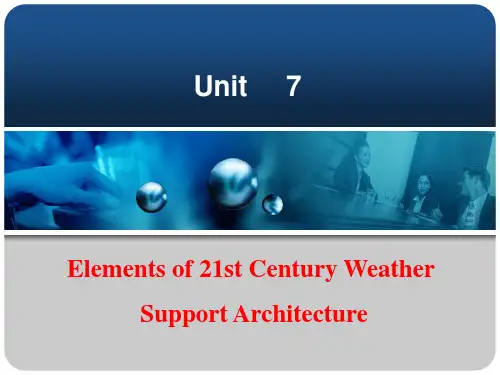
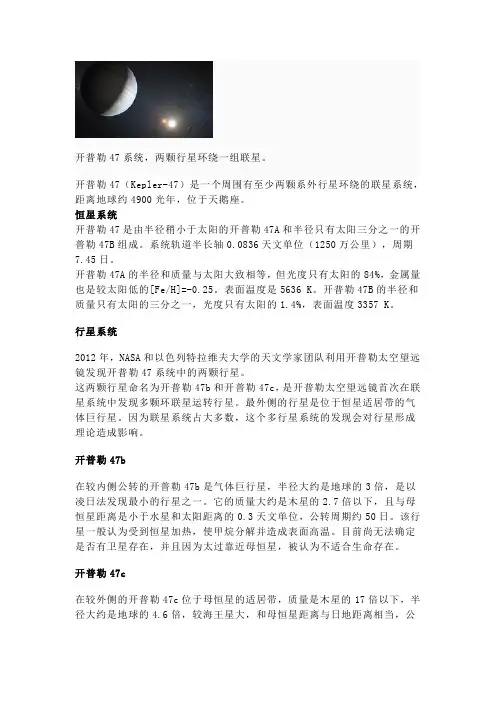
开普勒47系统,两颗行星环绕一组联星。
开普勒47(Kepler-47)是一个周围有至少两颗系外行星环绕的联星系统,距离地球约4900光年,位于天鹅座。
恒星系统开普勒47是由半径稍小于太阳的开普勒47A和半径只有太阳三分之一的开普勒47B组成。
系统轨道半长轴0.0836天文单位(1250万公里),周期7.45日。
开普勒47A的半径和质量与太阳大致相等,但光度只有太阳的84%,金属量也是较太阳低的[Fe/H]=-0.25。
表面温度是5636 K。
开普勒47B的半径和质量只有太阳的三分之一,光度只有太阳的1.4%,表面温度3357 K。
行星系统2012年,NASA和以色列特拉维夫大学的天文学家团队利用开普勒太空望远镜发现开普勒47系统中的两颗行星。
这两颗行星命名为开普勒47b和开普勒47c,是开普勒太空望远镜首次在联星系统中发现多颗环联星运转行星。
最外侧的行星是位于恒星适居带的气体巨行星。
因为联星系统占大多数,这个多行星系统的发现会对行星形成理论造成影响。
开普勒47b在较内侧公转的开普勒47b是气体巨行星,半径大约是地球的3倍,是以凌日法发现最小的行星之一。
它的质量大约是木星的2.7倍以下,且与母恒星距离是小于水星和太阳距离的0.3天文单位,公转周期约50日。
该行星一般认为受到恒星加热,使甲烷分解并造成表面高温。
目前尚无法确定是否有卫星存在,并且因为太过靠近母恒星,被认为不适合生命存在。
开普勒47c在较外侧的开普勒47c位于母恒星的适居带,质量是木星的17倍以下,半径大约是地球的4.6倍,较海王星大,和母恒星距离与日地距离相当,公转周期303日。
虽然一般假设开普勒47c并不适合生命生存,开普勒47c 的体积仍被认为能让有水蒸气云的浓厚大气层存在。
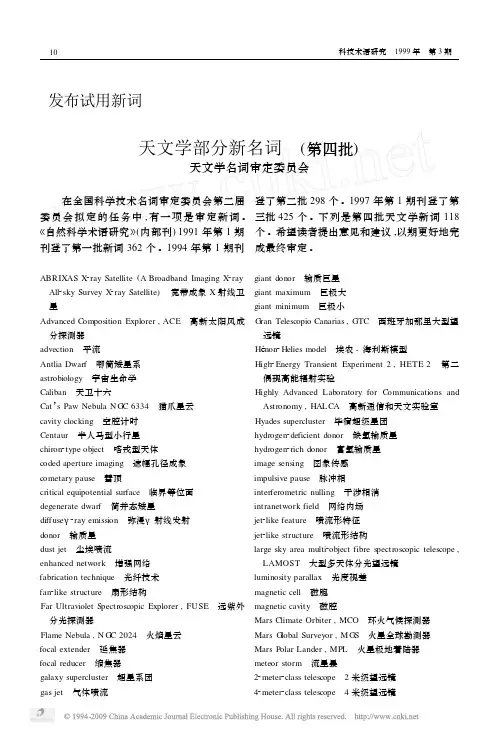
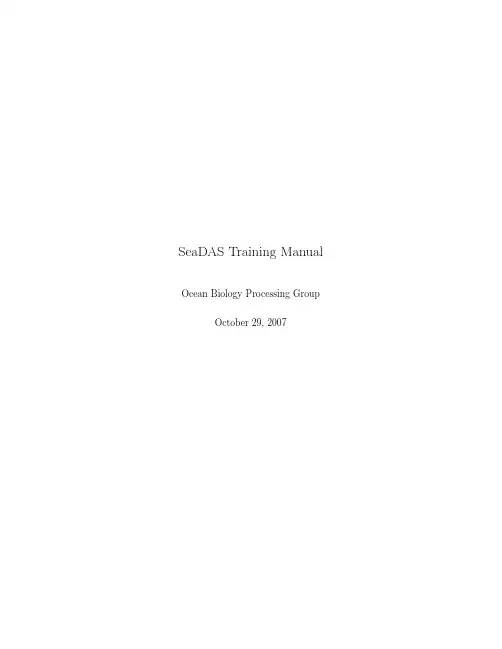
SeaDAS Training Manual Ocean Biology Processing GroupOctober29,20072Chapter1An Introduction to the OBPGIntroductionThis chapter introduces the NASA Ocean Biology Processing Group(OBPG)and the software used in conjunction with data distributed by the group,the SeaWiFS Data Analysis System(SeaDAS).1.1What is the OBPG?The goal of the Ocean Biology Processing Group is to make available the highest quality ocean color and SST data to the broadest user community in the most timely and efficient manner possible.More specifically the OBGP is the:•Designated NASA team responsible for the processing and distribution of ocean color and SST data from various spaceborne instruments:–Ocean Color:MODIS/Aqua,MODIS/Terra,SeaWiFS,OCTS,CZCS–SST:MODIS/Aqua,MODIS/Terra•Product Evaluation and Test Element(PEATE)for OC and SST on NPP/VIIRS•Science Team Lead for OC on NPP/VIIRS.•Designated as the software development,processing,and distribution element for Sea Surface Salinity measurements from Aquarius.1.2What Services does the OBPG Provide?The primary service provided by the OBPG is data distribution,the details of which are covered in the next chapter.Main features of the data distribution system are:•Instant access:entire archive of Level-1A through Level-3data for all missions is stored online •Minimal latency:MODIS L0/L1A/GEO/L1B/L2data available2-5hours after satellite observation •Web-based browser:simple viewing/order/download tool for the entire multi-mission data set •Full ftp access:data may be downloaded via ftp34CHAPTER1.AN INTRODUCTION TO THE OBPG •Data subscriptions:automatic staging of new data products to user-specific ftp accountsThe other main service provided by the OBPG is user support for accessing,understanding,process-ing,and working with the data.A great deal of this support takes place on the Ocean Color Forum (/forum/oceancolor/forum show.pl)and through documentation available on the Ocean Color Web(/).Figure1.1:The Ocean Color Web1.3.WHAT DATA DOES THE OBPG PROVIDE?5 1.3What Data does the OBPG Provide?As mentioned,the OBPG provides ocean color data from the MODIS/Aqua,MODIS/Terra,SeaWiFS, OCTS,and CZCS sensors,and SST data from MODIS/Aqua and MODIS/Terra.Data levels range from Level-0or Level-1A up to Level-3Binned and mapped products.The Level-2and Level-3data contain geophysical products,some of which are listed below.(Hundreds of predefined products and unlimited custom products can be created using the SeaDAS software package.)•Standard Ocean Color Products(all sensors,daytime only)–Normalized water-leaving radiances,nLw(λ)–Chlorophyll,C a–Diffuse attenuation,K d(490)–Aerosol type and concentration–Optical thickness,τa–˚A ngstr¨o m exponent–Atmospheric epsilon–Processingflags–Cloud,land,glint,atmfail,atmwarn,chlfail,chlwarn,etc.•Standard Ocean Temperature Products(MODIS only)–Long-wave SST(11-12µm)(daytime and nighttime)–Short-wave SST(3.9-4.0µm)(nighttime only)–SST quality level(0-4)•Non-standard Ocean Color Products(all sensors,daytime only)–Alternate C a and K d algorithms–Chlorophyllfluorescence,FLH–Particulate inorganic carbon,Calcite–Inherent optical properties(various bio-optical models)–absorption(total,phaeophytin,dissolved matter)–backscatter(total,particulate)–Photosynthetically active radiation,iPAR,PAR–Euphotic depth(Z eu,Z sd)–Subsurface PAR at1st optical depth,K d(PAR)–Intermediate atmospheric correction products–..and many others•Non-standard Ocean Temperature Products(MODIS only)–Brightness temperatures(daytime and nighttime)6CHAPTER1.AN INTRODUCTION TO THE OBPG 1.4What is SeaDAS?SeaDAS is a comprehensive image analysis package for the processing,display,analysis,and quality control of ocean color data.SeaDAS is intended for use with all of the OBPG supported sensors:MODIS/Aqua, MODIS/Terra,SeaWiFS,OCTS,CZCS.SeaDAS can also be very useful as a general scientific imagery/data analysis package.SeaDAS features include:•Visualize and manipulate all data distributed by the OBPG•Visualize and manipulate non-OBPG data(e.g.general HDF4,AVHRR Pathfinder)•Process all data from L0or L1A through to L3and SMI(complete source code included)•Reproduce products identical to the OBPG standard ocean color and SST products•NPP/VIIRS will be supported in the future•Runs on UNIX-like systems only:Linux,Macintosh OS X,Sun Solaris,SGI IRIX•Direct user support and extremely active user support forumsFigure1.2:The SeaDAS Home Page1.4.WHAT IS SEADAS?7 The SeaDAS GUI and most data visualization/manipulation functions are written in the Interactive Data Language(IDL),made by ITT Visual Information Solutions(ITT VIS).IDL is a scientific programming language and scientific environment similar in many ways to Matlab.It is not necessary to purchase IDL in order to have access to full SeaDAS functionality.Figure1.3:The Main SeaDAS GUI Window1.4.1SeaDAS Modes of OperationSeaDAS functionality can be accessed in a variety of ways:•Using the Graphical User Interface(GUI)–Virtually all SeaDAS functionalities are accessible via the GUI.The GUI is often a good way to learn about the capabilities of SeaDAS and to work with single datafiles.Once a user determineshis or her goal and accomplishes a task using the GUI,it is often more efficient to automate thesteps by using a command-line approach.•Using the SeaDAS command-line–The SeaDAS command-line is available to those who have purchased a full IDL license from ITT.The SeaDAS command-line is actually an IDL command-line that provides access to both SeaDASand IDL commands.Almost all SeaDAS processing,display,visualization,and manipulationfunctions can be accessed on the SeaDAS command-line in concert with IDL commands.•Using the UNIX command-line–All SeaDAS processing capabilities are also accessible via the UNIX command-line.This includes L0to L3processing(including automatic ancillary data determination and retrieval),as well asfunctions for subscening datafiles and generating true-color mapped image products.None ofSeaDAS’graphics capabilities are available on the UNIX command-line.•Automating SeaDAS using IDL scripts and/or UNIX shell scripts–Virtually any series of SeaDAS processing and graphics operations can be automated by writing IDL scripts.These scripts can combine both SeaDAS and IDL commands(and optionally spawnUNIX commands)to perform complex data operations.This feature does not require thepurchase of IDL.–For data processing,UNIX shell scripts can be used to easily automate the subscening and pro-cessing of multiple datafiles from L0through to L3.IDL scripts can also be called from suchUNIX shell scripts to access SeaDAS display,visualization,and manipulation functions.1.4.2Components of the SeaDAS DistributionThe SeaDAS distribution package is primarily made up of IDL code,C binaries and libraries,and UNIX shell scripts.The SeaDAS GUI is written in IDL code as are various image and data manipulation functions. Binaries(executablefiles created by compiling C and Fortran code)are used for data processing(e.g.the msl12binary used for L1to L2processing).SeaDAS also makes use of HDF binaries and libraries.Shell scripts(executable textfiles containing various UNIX and shell commands)are mainly used as wrappers for data processing(e.g.modis L1A to L1B.csh).Other shell scripts exist as stand-alone utility scripts(e.g. the ms met.csh script for meteorological ancillary data determination and retrieval).8CHAPTER1.AN INTRODUCTION TO THE OBPG 1.4.3SeaDAS SupportAs mentioned direct user support and extremely active user support forums are available for SeaDAS users. Direct support can be obtain via email(seadas@)or by phone.However,most support occurs in the Ocean Color Forum(/forum/oceancolor/forum show.pl),where announcements are made and both technical and scientific questions and discussions take place.SeaDAS-specific technical questions are asked on the‘SeaDAS:General Questions’board,data access questions on the‘Satellite Data Access’board,and scientific queries on the‘Satellite Data Products&Algorithms’board. TIP SeaDAS GUI windows have a Help button that will spawn that window’s local help webpage.All SeaDAS-specific help documents are also available online:/seadas/help.htmlFigure1.4:The Ocean Color ForumChapter2An Overview of Ocean Data LevelsIntroductionAs mentioned,the OBPG is the designated NASA team responsible for the processing and distribution of ocean color and SST data acquired from the MODIS/Aqua,MODIS/Terra,SeaWiFS,OCTS,and CZCS sensors.This chapter discusses the standard NASA data levels used for storing ocean color satellite data. These data levels are distributed by the OBPG and/or are producible by the SeaDAS software package. GoalThis chapter gives an introduction to the HDFfile format and briefly describes the following standard OBPG satellite ocean data levels:•Level-0•Level-1A•MODIS GEO•Level-1B•Level-2•Level-3Binned•Level-3Standard Mapped Images2.1HDF and HDF-EOS Data FormatsOBPG Level-1A to Level-3datafiles are stored in the HDFfile format.HDF can be thought of as a ‘container’that can store a variety of data types and meta data in a singlefile(see Figure2.1).From the NASA Atmospheric Science Data Center:Hierarchical Data Format(HDF)is a data file format designed by the National Center for Supercomputing Applications(NCSA)to assist users in the storage and manipulation of scientific data across diverse operating systems and machines.NCSA developed a library of callable routines and a set of utility programs and tools for creating and using HDF files.This work is now performed by The HDF Group(THG).OBPGfiles are actually stored in the HDF-EOS format,a specialized form of HDF created by NASA in1993 as a standard format for all data generated by instruments on the Earth Observing System(EOS)satellites. TIP SeaDAS is fully compatible with all OBPG HDF-EOS datafiles.910CHAPTER2.AN OVERVIEW OF OCEAN DATA LEVELSFigure2.1:HDF File Example(Curtesy of The HDF Group)2.2Level-0DataLevel-0(L0)datafiles contain the raw radiance counts(digital numbers)and this is the lowest and most raw level of data normally available to end-users.L0data is rarely utilized by end-users since the Level-1A(L1A)data is usually a simple re-organization of the L0data into the more friendly/standardized HDF-EOS format.However,L0data from MODIS Aqua and Terra may be desired because unlike MODIS L1A data(which has been ocean-band-subsetted),MODIS L0data contains all36MODIS bands including the7high resolution bands,some of which may be useful for oceanic pro-cessing.As of July2007,all MODIS L0data is available from the singlefile selection page of the OBPG Level1and2Browser.A rolling60-day archive of L0MODIS Aqua and Terra data is also available via ftp:///.TIP SeaDAS has the ability to process L0data to L1A for only the MODIS and SeaWiFS sensors,and can display only L0SeaWiFS data.2.3Level-1A DataL1A datafiles contain the sensor raw radiance counts(digital numbers)as well as spacecraft and instrument telemetry and calibration data.Navigation data is also included except for MODIS,in which case the geolocation data is contained in a separatefile.All L1Afilenames use the SeaWiFS-like convention,which indicates sensor(e.g.S for SeaWiFS,A for MODIS-Aqua,T for MODIS-Terra),sampling rate(C for full1-km sampling),and time of thefirst scan in thefile(e.g.AYYYYDDDHHMMSS.L1A LAC).The entire mission archive of L1A ocean data for all sensors is maintained online,and all higher-level products are derived from this archive.Due to the ever-changing nature of L1B calibration coefficients for active missions,it is recommended that researchers who intend to generate their own L2 products begin their processing using the L1A data(and an up-to-date version of SeaDAS).2.4.MODIS GEO DATA11 OBPG MODIS L0to L1A processing is performed using the standard code developed by the MODIS Science Data Support Team(SDST)and all MODIS L0and L1Afiles distributed by the OBPG are5-minute granules. Forfile size and bandwidth reasons,MODIS L1Afiles are reduced(band-subsetted)by removing excess bands and data that are not utilized for oceanic processing.A standard MODIS L1Afile is∼575MB(∼220MB compressed),while a band-subsetted L1Afile is∼215MB(∼50MB compressed).The reduced Ocean L1A file format retains the bands shown in Figure2.2).Figure2.2:MODIS Ocean Subset Band List2.4MODIS GEO DataFor the MODIS sensor only,a separate geolocation(GEO)file must be generated from an L1Afile,and contains the navigation for that granule.L1B and L2processing then requires the GEOfile as an input. The naming convention for GEOfiles is similar to that of the L1Afiles,e.g.AYYYYDDDHHMMSS.GEO. GEOfiles are not maintained in the long-term OBPG archive since they can be regenerated as needed using SeaDAS,so only a short-term rolling archive is made available for distribution by the OBPG.For the OBPG distribution’s NRT stream,predicted attitude and ephemerisfiles are used to produce Quick-Look GEOfiles. Several days later,in the Refined processing stream,the definitive attitude and ephemerisfiles are used to create thefinal GEO version and refined data products.2.5Level-1B DataLevel-1B datafiles contain the calibrated at-aperture(top-of-atmosphere)radiances derived from L1A sensor counts by applying the sensor calibration.L1Bfiles are named similarly to L1Afiles,e.g.AYYYYDDDHH-MMSS.L1B LAC or simply AYYYYDDDHHMMSS.L1B.For non-MODIS sensors the end-user will rarely make use of L1Bfiles since the processing software produces a L2file directly from an L1A input.However,for MODIS processing,generat-ing the L1Bfile is a required separate step.If the input MODIS L1Afile is not band-subsetted,separate high resolution L1Bfiles will also be produced,e.g.AYYYYDDDHHMMSS.L1B HKM,AYYYYDDDHH-MMSS.L1B QKM.There are differences between the MODIS L1Bfiles produced by the OBPG and those from the MODIS Calibration Support Team(MCST).First,since ocean pixels are generally much darker than land and cloud pixels,a higher level of precision is required for ocean processing.Therefore the OBGPfine-tunes the MCST calibration coefficients for ocean data and so the ocean radiances will be slightly different(and hopefully improved).Second,the OBPG uses the ocean subsetted L1Afiles as input to the L1B processing so OBPG L1Bfiles will contain only the bands listed in Figure2.2.However,if SeaDAS is used to process12CHAPTER 2.AN OVERVIEW OF OCEAN DATA LEVELS a non-subsetted L1A file,all the non-high-resolution MODIS bands will be present in the L1B file (the high-resolution bands will exist in separate L1B HKM ad QKM files).2.6Level-2DataLevel-2data files contain calculated geophysical values for each pixel (e.g.nLw’s,Chlorophyll-a,SST)derived from the L1B radiances by applying atmospheric corrections and bio-optical algorithms.L2data files also contain geolocation data.Each L2product corresponds exactly in geographical coverage (scan-line and pixel extent)to its parent L1A product and is stored in one physical HDF file.As with previous levels,the data has not been mapped and so is in “satelliteview”.Figure 2.3:Level-2Chlorophyll-a Product L2filenames have the form AYYYYDDDHHMMSS.L2LAC.MODIS SST products require different processing parame-ters than other ocean products,therefore MODIS SST L2files are generated in a separate processing run and arenamed AYYYYDDDHHMMSS.L2LAC SST or TYYYYD-DDHHMMSS.L2LAC SST.The L2files distributed by the OBPG contain a standardsuite of products including water-leaving radiances,chloro-phyll a concentration,the diffuse attenuation coefficient at490nm,and a few other products.In addition,thirty-twoflags are associated with each pixel indicating if any algo-rithm failures or warning conditions occurred for that pixel.These flags exist in the ‘l2flags’product.The separatestandard MODIS SST files contain the 11µand 4µ(night-time only)SST products.Five quality levels are associatedwith these SST products and are stored in the ‘qual sst’and ‘qual sst4’ing SeaDAS,L2files can be creatingthat contain hundreds of pre-defined products and/or customproducts.Level-2processing is performed using the Multi-Sensor Level-1to Level-2(msl12)code,which is devel-oped and maintained by the OBPG.msl12is used for the standard processing of all ocean products dis-tributed through the OBPG web browsers and ftp sites.This software is capable of retrieving oceanic optical properties and a multitude of derived products from the observed top-of-atmosphere (TOA)radi-ances.For non-MODIS sensors the L1A file is input to msl12,and for MODIS the L1B and GEO files are used as input.Full documentation,source code,and output product descriptions can be found at /DOCS/MSL12/.2.7Level-3Binned DataLevel-3Binned (L3b)data files contain spatially and temporally binned L2data products.In other words,an L3b data file consists of the accumulated L2data statistics for the specified instrument,product(s),spatial resolution,and time period.Bins can be thought of as square grid elements or grid cells.(Prior to L3b,geophysical variables are derived only for individual satellite pixels.)The statistical data provided in L3b files allow for the calculation of the mean,standard deviation,median,and mode for each L2variable,and for certain other variables (e.g.primary productivity)which are functions of the L2variables.The L3b data are stored in a representation of a global,sinusoidal equal-area grid (see Figure 2.4),and the standard OBPG-distributed bin resolutions are either 4.6km or 9.2km (certain regional products are 1km resolution).Only those bins containing data values are present in the L3b file;land bins and bins with no data are not stored.To create L3b files,the L2files are spatially averaged into L3Daily2.7.LEVEL-3BINNED DATA13 binnedfiles using the l2bin program,and the Dailyfiles are further composited into Weekly,Monthly, Annual,Seasonal,and Climatological time periods using the l3bin program.TIP SeaDAS can be used to create an L3b composite for an arbitrary time period,and the available SeaDAS binning resolutions are0.5,1,2,4,9,and36kilometers.Figure2.4:Square Bins Defined by a Sinusoidal Equal-Area ProjectionThe full suite of L2ocean color parameters as well as three sea surface temperature parameters are available as standard temporal composites from the OBGP.Each product contains only data that has met data quality standards as indicated by a selected standard set of L2flags and masks.SST products can contain data of varying data quality levels,but each bin will only contain the best quality data available for the time period. L3b products are stored either in a single,self-containedfile,or else in separate datafiles known as subor-dinates(for bandwidth and disk space considerations).Single-file L3b products havefilenames of the form IYYYYDDDYYYYDDD.L3b TTT,where I is the instrument identifier,YYYYDDDYYYYDDD are the concatenated digits for the GMT year and day of the start and end days of the binning period,and TTT is a code for the binning period length(DAY,8D,MO,YR,etc.).For daily products,only the year and day of the data are used.For the multi-file L3b products a‘main’file exists,containing all product-level metadata and other data common to all the binned geophysical parameters,along with the multiple subordinatefiles,each of which contains the data of one binned geophysical parameter.An example of thefilenames used for a multi-file SeaWiFS L3b Daily product is:S1998001.L3b DAY.mainS1998001.L3b DAY.x00S1998001.L3b DAY.x01...S1998001.L3b DAY.x10Although it is not necessary to know which subordinatefile stores which product(SeaDAS automatically14CHAPTER2.AN OVERVIEW OF OCEAN DATA LEVELS handles this),each extension number(x00,x11,etc.)is permanently assigned to a certain geophysical product.For example,the extension numbers for SeaWiFS are assigned as follows:x00−→nLw412x00−→nLw412x01−→nLw443x02−→nLw490x03−→nLw510x04−→nLw555x05−→nLw670x06−→angstrom510x07−→chlor ax08−→K490x09−→eps78x10−→tau865TIP L3Binned data products are stored as VDATA HDF objects within the datafiles,so any HDF utility such as vshow can be used to obtain information about the contents of the datafiles.More L3b documentation including algorithms used for spatial and temporal binning are listed in the OBPG Algorithms and Products FAQ:/forum/oceancolor/topic show.pl?tid=19592.8Level-3Standard Mapped ImagesA Level-3Standard Mapped Image(SMI)is an equidistant cylindrical projection of the arithmetic means derived from the statistical data of one Level-3Binned geophysical product.(The equidistant cylindrical projection is also called the equirectangular projection or geographic projection.)Therefore SMI products are image representations of binned data products over the period covered by the parent product.The OBPG distributes global SMI maps at4.6km(4320×2160)and9.2km(8640×4320)resolution to match the L3b standard resolutions.Grid points for the entire globe are present in the datafiles,including an assignedfill value for land and missing data points.SMIfiles are distributed both as HDFfiles and as PNG (Portable Network Graphics)imagefiles.The SMI HDF productfiles are created using the smigen program.Figure2.5:8-Day Level-3Standard Mapped Image(MODIS Aqua Chlorophyll-a,June2007)2.8.LEVEL-3STANDARD MAPPED IMAGES15 All of the OBPG-distributed SMI products are stored as16-bit integers(scaled down from the32-bitfloating-point L3b products).Due to scaling of the L3b data values and problems that may arise from mapping,researchers should fully understand the issues involved with the SMI format before using these maps for scientific purposes.Often using the L3Binned data directly instead of mapping the bins may be the best approach.TIP SeaDAS has theflexibilty to create SMI maps as8-bit integer data,16-bit integer data,or32-bit floating-point data at1,2,4,4.6,9,9.2,or36kilometer resolutions.16CHAPTER2.AN OVERVIEW OF OCEAN DATA LEVELSChapter3Obtaining Ocean DataIntroductionAs mentioned,the OBPG is the designated NASA team responsible for the distribution of ocean color and SST data acquired from the MODIS/Aqua,MODIS/Terra,SeaWiFS,OCTS,and CZCS sensors(this role had been previously shared by the NASA Goddard DAAC).The OBPG offers complete historical archives for each sensor,as well as near real-time(NRT)data for active missions.The access point for all OBPG data sets is the main OBPG webpage,the Ocean Color Web(/).GoalThis chapter outlines the various data access methods available via the Ocean Color Web.Each method for data access will be briefly discussed:•Historical Data Access–SeaWiFS Data Access–The Level1and2Browser–The Level3Browser–Data by FTP•Near Real-Time Data Access–Data Subscriptions for NRT Data–NRT Extracts and Maps–Data by FTP•Citing Data Products Obtained from the Ocean Color Web3.1Historical Data AccessComplete historical data archives for all sensors are available for immediate download from the OBPG servers,with the exception of certain SeaWiFS data restrictions(see below).Data from active missions are made available as soon as the processing system can ingest and process it(MODIS/Aqua and MODIS/Terra data is normally available within2-5hours of capture).1718CHAPTER3.OBTAINING OCEAN DATA 3.1.1SeaWiFS Data AccessThe only OBPG-distributed sensor data with access restrictions is SeaWiFS data,which is currently under a two week embargo from date of collection(per the contractual agreement with GeoEye).Therefore SeaWiFS files less than two weeks old are unavailable.All SeaWiFS data greater thanfive years old is publicly available,but data less thanfive years old is not available to the general public unless they become a SeaWiFS Authorized User.To become an authorized user one must make a(brief)request to the OBGP specifying the scientific rationale for the request along with some other information(see /cgi/apply.pl?page=du).Authorized users can then use the‘SeaWiFS User Login’button in the data browser to gain access to all the SeaWiFS data. On December24,2004,the SeaWiFS project stopped receiving global data from HRPT stations(from which the MLAC data are produced).Since that time the OBPG contract with OrbIMAGE(now GeoEYE)is only for the global GAC dataset,and a new agreement has also provided the OBGP with the coastal U.S. 1km dataset.A request for recorded LAC data can also be made to the OBPG for cruise support,but NRT MODIS1km data is now the preferred source.For non-coastal U.S.1km data after Dec24,2004,data can be purchased directly from GeoEYE.3.1.2The Level1and2BrowserThe‘Level1and2Browser’link on the Ocean Color Web homepage accesses the main browser interface for selecting,downloading,and ordering Level-1and-2datafiles(as well as MODIS L0files).From this top-level interface,search criteria can be set and then searches launched for the matching Level-1and-2 scenes(using the‘Find swaths’button or by clicking on the map).Figure3.1:The Level1and2Browser3.1.HISTORICAL DATA ACCESS19 Search criteria of the data browser include:•Sensor(s)•Day and/or night scenes•Geographic location defined by:–A predefined area of interest–User-specified area of interest(lat/lon box)–Scenes directly under mouse click on global map–Radius about mouse click on global map–Radius about specified lat/lon–Minimum percent of swath falling within area of interest–Date range(contiguous or non-contiguous)When using the data browser,a‘Help’button is available in the upper-righthand corner of each different type of browser page to provide help topics for all the functionalities on that page.Since this help feature details all of the minute functions of the browser,these details will not be discussed here.After a search has been launched using the‘Find swaths’button or by clicking a location on the global map, the search results will be displayed on a new browser page.If only one swath was found,then that swath’s files will be listed as hyperlinks for immediate download along with thumbnail browse images of the data. If more than one swath matches the search criteria,the results page will display multiple matching swath filenames and thumbnails(10per page by default).An individual swath can be selected by clicking on its filename link,or a swath can be added to a user’s‘shopping cart’by clicking the asterisks link(“****”).At any time clicking the‘ORDER DATA’button will take the user to the Scene Order Form page.Figure3.2:Level1and2Browser Search Results20CHAPTER3.OBTAINING OCEAN DATA On the Scene Order Form page the order can be viewed and the user must specify:•An email address•Whether or not to extract a specific region from the datafiles•Data levels desired•Level-2Data products desiredFigure3.3:Level1and2Browser Order FormNext,the‘Review order’button is clicked to continue to the Order Review page that will list allfiles to be staged.If the order looks correct,the user can then click the‘Submit Order’button to complete the Order. Once an order is submitted the OBPG server will begin staging the requestedfiles and send an email notification when thefiles are available for download.The entire ordering and staging process is completely automated so many orders will be available within minutes of submission.3.1.3The Level3BrowserThe‘Level3Browser’link on the Ocean Color Web homepage accesses the interface for selecting and downloading the entire Level-3global ocean color data set for many parameters and time periods.The Level-3files in this browser have been converted from Level-3Binned datafiles to Standard Mapped Images stored both as digital data in HDF formattedfiles and as PNG images.Both4km and9km data are available.A variety of standard and evaluation products can be selected,and clicking on the timeline will set a start date for products to be displayed.Below the timeline is a table of thumbnail images depicting global projections of the selected product type during various time periods.Next to the thumbnails are hyperlinks to the4km (4320x2160)and9km(8640x4320)HDF and PNGfiles.Each column in the table is associated with time periods of afixed length such as a year,a season,a month,or an eight-day‘weekly’period.Clicking on the。
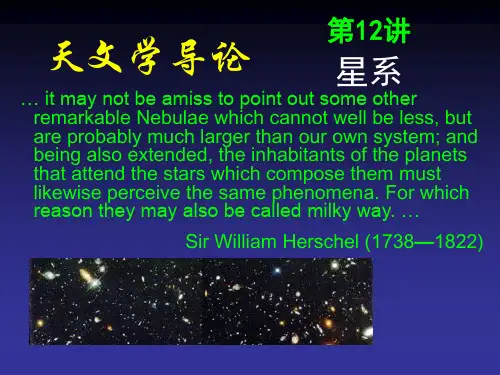
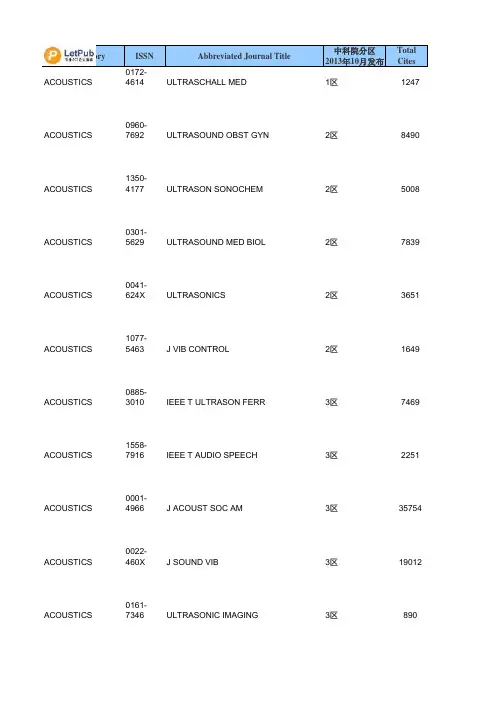
Subcategory ISSN Abbreviated Journal Title中科院分区2013年10月发TotalCitesACOUSTICS0960-7692ULTRASOUND OBST GYN2区 8490 ACOUSTICS1350-4177ULTRASON SONOCHEM2区 5008 ACOUSTICS0301-5629ULTRASOUND MED BIOL2区 7839 ACOUSTICS0041-624XULTRASONICS2区 3651 ACOUSTICS1077-5463J VIB CONTROL2区 1649 ACOUSTICS0885-3010IEEE T ULTRASON FERR3区 7469 ACOUSTICS1558-7916IEEE T AUDIO SPEECH3区 2251 ACOUSTICS0001-4966J ACOUST SOC AM3区 35754 ACOUSTICS0022-460XJ SOUND VIB3区 19012 ACOUSTICS0161-7346ULTRASONIC IMAGING3区 890 ACOUSTICS0165-2125WAVE MOTION3区 1367 ACOUSTICS0278-4297J ULTRAS MED3区 3907 ACOUSTICS0167-6393SPEECH COMMUN3区 1982 ACOUSTICS1048-9002J VIB ACOUST3区 1825 ACOUSTICS0003-682XAPPL ACOUST4区 1975 ACOUSTICS1549-4950J AUDIO ENG SOC4区 832 ACOUSTICS0137-5075ARCH ACOUST4区 242 ACOUSTICS1610-1928ACTA ACUST UNITED AC4区 1808 ACOUSTICS0091-2751J CLIN ULTRASOUND4区 1642 ACOUSTICS0031-8388PHONETICA4区 570 ACOUSTICS0218-396XJ COMPUT ACOUST4区 328 ACOUSTICS1687-4722EURASIP J AUDIO SPEE4区 59 ACOUSTICS1475-472XINT J AEROACOUST4区 190 ACOUSTICS1070-9622SHOCK VIB4区 320 ACOUSTICS1063-7710ACOUST PHYS+4区 600 ACOUSTICS1027-5851INT J ACOUST VIB4区 57 ACOUSTICS0736-2501NOISE CONTROL ENG J4区 273 ACOUSTICS0814-6039ACOUST AUST4区 49 ACOUSTICS0263-0923J LOW FREQ NOISE V A4区 79 ACOUSTICS1541-0161SOUND VIB4区 195 AGRICULTURAL ECON0306-9192FOOD POLICY2区 1736 AGRICULTURAL ECON0165-1587EUR REV AGRIC ECON2区 744 AGRICULTURAL ECON2040-5790APPL ECON PERSPECT P3区 101 AGRICULTURAL ECON0021-857XJ AGR ECON3区 829 AGRICULTURAL ECON1364-985XAUST J AGR RESOUR EC3区 473 AGRICULTURAL ECON0169-5150AGR ECON-BLACKWELL3区 1284 AGRICULTURAL ECON0002-9092AM J AGR ECON4区 4462 AGRICULTURAL ECON0008-3976CAN J AGR ECON4区 378 AGRICULTURAL ECON1068-5502J AGR RESOUR ECON4区 534 AGRICULTURAL ECON1756-137XCHINA AGR ECON REV4区 43 AGRICULTURAL ECON1559-2448INT FOOD AGRIBUS MAN4区 199 AGRICULTURAL ECON1699-6887ITEA-INF TEC ECON AG4区 54 AGRICULTURAL ECON0303-1853AGREKON4区 104 AGRICULTURAL ECON1808-2882CUST AGRONEGOCIO4区 3 AGRICULTURAL ENGIN0960-8524BIORESOURCE TECHNOL2区 44257 AGRICULTURAL ENGIN0961-9534BIOMASS BIOENERG2区 10805 AGRICULTURAL ENGIN0926-6690IND CROP PROD3区 4151 AGRICULTURAL ENGIN0144-8609AQUACULT ENG3区 1214 AGRICULTURAL ENGIN1537-5110BIOSYST ENG3区 2799 AGRICULTURAL ENGIN0733-9437J IRRIG DRAIN E-ASCE4区 2413 AGRICULTURAL ENGIN1611-2490PADDY WATER ENVIRON4区 2462151-0032T ASABE4区 6871 AGRICULTURAL ENGIN0100-6916ENG AGR-JABOTICABAL4区 568 AGRICULTURAL ENGIN1415-4366REV BRAS ENG AGR AMB4区 1022 AGRICULTURAL ENGIN0883-8542APPL ENG AGRIC4区 1234 AGRICULTURAL ENGIN0084-5841AMA-AGR MECH ASIA AF4区 90 AGRICULTURAL ENGINAGRICULTURE, DAIRY0999-193XGENET SEL EVOL1区 1539 AGRICULTURE, DAIRY0268-9146ANIM GENET1区 3284 AGRICULTURE, DAIRY0022-0302J DAIRY SCI2区 29407 AGRICULTURE, DAIRY0739-7240DOMEST ANIM ENDOCRIN2区 1927 AGRICULTURE, DAIRY0021-8812J ANIM SCI2区 23776 AGRICULTURE, DAIRY0378-4320ANIM REPROD SCI2区 5803 AGRICULTURE, DAIRY0916-8818J REPROD DEVELOP2区 1622 AGRICULTURE, DAIRY0931-2668J ANIM BREED GENET2区 1150 AGRICULTURE, DAIRY1751-7311ANIMAL2区 1894 AGRICULTURE, DAIRY0377-8401ANIM FEED SCI TECH2区 6366 AGRICULTURE, DAIRY0032-5791POULTRY SCI3区 13639 AGRICULTURE, DAIRY0168-1591APPL ANIM BEHAV SCI3区 5989 AGRICULTURE, DAIRY0936-6768REPROD DOMEST ANIM3区 2880 AGRICULTURE, DAIRY0022-0299J DAIRY RES3区 2641 AGRICULTURE, DAIRY0931-2439J ANIM PHYSIOL AN N3区 1202 AGRICULTURE, DAIRY1871-1413LIVEST SCI3区 2542 AGRICULTURE, DAIRY0043-9339WORLD POULTRY SCI J3区 1320 AGRICULTURE, DAIRY0007-1668BRIT POULTRY SCI3区 3285 AGRICULTURE, DAIRY0921-4488SMALL RUMINANT RES3区 4134 AGRICULTURE, DAIRY1745-039XARCH ANIM NUTR3区 629 AGRICULTURE, DAIRY0049-4747TROP ANIM HEALTH PRO3区 1749 AGRICULTURE, DAIRY1344-3941ANIM SCI J3区 737 AGRICULTURE, DAIRY0008-3984CAN J ANIM SCI3区 1829 AGRICULTURE, DAIRY1212-1819CZECH J ANIM SCI3区 613 AGRICULTURE, DAIRY0860-4037ANIM SCI PAP REP3区 306 AGRICULTURE, DAIRY1049-5398ANIM BIOTECHNOL3区 330 AGRICULTURE, DAIRY1056-6171J APPL POULTRY RES4区 1465 AGRICULTURE, DAIRY1594-4077ITAL J ANIM SCI4区 676 AGRICULTURE, DAIRY1230-1388J ANIM FEED SCI4区 560 AGRICULTURE, DAIRY0990-0632PROD ANIM4区 263 AGRICULTURE, DAIRY1346-7395J POULT SCI4区 308 AGRICULTURE, DAIRY1758-1559AVIAN BIOL RES4区 43 AGRICULTURE, DAIRY1011-2367ASIAN AUSTRAL J ANIM4区 1609 AGRICULTURE, DAIRY1257-5011WORLD RABBIT SCI4区 269 AGRICULTURE, DAIRY0906-4702ACTA AGR SCAND A-AN4区 427 AGRICULTURE, DAIRY0990-0632INRA PROD ANIM4区 126 AGRICULTURE, DAIRY0375-1589S AFR J ANIM SCI4区 544 AGRICULTURE, DAIRY0003-9438ARCH TIERZUCHT4区 456 AGRICULTURE, DAIRY1642-3402ANN ANIM SCI4区 135 AGRICULTURE, DAIRY0004-9433AUST J DAIRY TECHNOL4区 360 AGRICULTURE, DAIRY0044-5401ZUCHTUNGSKUNDE4区 167 AGRICULTURE, DAIRY0003-9098ARCH GEFLUGELKD4区 323 AGRICULTURE, DAIRY0429-2766FOURRAGES4区 251 AGRICULTURE, DAIRY0972-2963ANIM NUTR FEED TECHN4区 78 AGRICULTURE, DAIRY1516-635XBRAZ J POULTRY SCI4区 280 AGRICULTURE, DAIRY2007-1124REV MEX CIENC PECU4区 25 AGRICULTURE, DAIRY0026-704XMLJEKARSTVO4区 90 AGRICULTURE, DAIRY0120-0690REV COLOMB CIENC PEC4区 69 AGRICULTURE, DAIRY0122-0268REV MVZ CORDOBA4区 56AGRICULTURE, DAIRY0367-8318INDIAN J ANIM SCI4区 733 AGRICULTURE, DAIRY0971-2119J APPL ANIM RES4区 221 AGRICULTURE, DAIRY1124-4593LARGE ANIM REV4区 31 AGRICULTURE, DAIRY0125-6726BUFFALO BULL4区 43 AGRICULTURE, DAIRY0367-6722INDIAN J ANIM RES4区 33 AGRICULTURE, MULTI0021-8561J AGR FOOD CHEM1区 76046 AGRICULTURE, MULTI0021-8596J AGR SCI1区 3886 AGRICULTURE, MULTI0167-8809AGR ECOSYST ENVIRON2区 10733 AGRICULTURE, MULTI0308-521XAGR SYST2区 2915 AGRICULTURE, MULTI0003-4746ANN APPL BIOL2区 3678 AGRICULTURE, MULTI0168-1699COMPUT ELECTRON AGR2区 2535 AGRICULTURE, MULTI0022-5142J SCI FOOD AGR2区 12723 AGRICULTURE, MULTI1670-567XICELAND AGR SCI2区 65 AGRICULTURE, MULTI1385-2256PRECIS AGRIC2区 703 AGRICULTURE, MULTI1473-5903INT J AGR SUSTAIN2区 275 AGRICULTURE, MULTI1537-5110BIOSYST ENG2区 2799 AGRICULTURE, MULTI0889-048XAGR HUM VALUES3区 790 AGRICULTURE, MULTI1187-7863J AGR ENVIRON ETHIC3区 494 AGRICULTURE, MULTI1573-5214NJAS-WAGEN J LIFE SC3区 528 AGRICULTURE, MULTI0552-9034PAK J AGR SCI3区 325 AGRICULTURE, MULTI1836-0939ANIM PROD SCI3区 541 AGRICULTURE, MULTI1836-0947CROP PASTURE SCI3区 537 AGRICULTURE, MULTI1742-1705RENEW AGR FOOD SYST3区 356 AGRICULTURE, MULTI0028-8233NEW ZEAL J AGR RES3区 1235 AGRICULTURE, MULTI0008-0845CALIF AGR3区 592 AGRICULTURE, MULTI1560-8530INT J AGRIC BIOL3区 1292 AGRICULTURE, MULTI0103-9016SCI AGR3区 1258 AGRICULTURE, MULTI1459-6067AGR FOOD SCI3区 363 AGRICULTURE, MULTI1044-0046J SUSTAIN AGR3区 462 AGRICULTURE, MULTI0045-6888REV CIENC AGRON3区 418 AGRICULTURE, MULTI1680-7073J AGR SCI TECH-IRAN3区 282 AGRICULTURE, MULTI0100-204XPESQUI AGROPECU BRAS3区 3338 AGRICULTURE, MULTI1695-971XSPAN J AGRIC RES3区 555 AGRICULTURE, MULTI1018-7081J ANIM PLANT SCI4区 240 AGRICULTURE, MULTI1861-3829J PLANT DIS PROTECT4区 305 AGRICULTURE, MULTI1166-7699CAH AGRIC4区 300 AGRICULTURE, MULTI1392-3196ZEMDIRBYSTE4区 138 AGRICULTURE, MULTI0718-5839CHIL J AGR RES4区 171 AGRICULTURE, MULTI0030-7270OUTLOOK AGR4区 289 AGRICULTURE, MULTI1671-2927AGR SCI CHINA4区 754 AGRICULTURE, MULTI1744-6961GRASSL SCI4区 215 AGRICULTURE, MULTI0021-3551JARQ-JPN AGR RES Q4区 421 AGRICULTURE, MULTI1413-7054CIENC AGROTEC4区 1168 AGRICULTURE, MULTI0005-9080BER LANDWIRTSCH4区 55 AGRICULTURE, MULTI0458-6859LANDBAUFORSCHUNG-GER4区 21 AGRICULTURE, MULTI0791-6833IRISH J AGR FOOD RES4区 190 AGRICULTURE, MULTI0031-7454PHILIPP AGRIC SCI4区 145 AGRICULTURE, MULTI1405-3195AGROCIENCIA-MEXICO4区 333 AGRICULTURE, MULTI0718-1620CIENC INVESTIG AGRAR4区 155 AGRICULTURE, MULTI1676-546XSEMIN-CIENC AGRAR4区 327 AGRICULTURE, MULTI1516-3725BIOSCI J4区 248 AGRICULTURE, MULTI0023-6152J FAC AGR KYUSHU U4区 205 AGRICULTURE, MULTI1594-5685NEW MEDIT4区 37 AGRICULTURE, MULTI0019-5022INDIAN J AGR SCI4区 776AGRICULTURE, MULTI0370-4661REV FAC CIENC AGRAR4区 36 AGRICULTURE, MULTI1663-7852AGRARFORSCH SCHWEIZ+4区 34 AGRICULTURE, MULTI1310-0351BULG J AGRIC SCI4区 115 AGRICULTURE, MULTI0122-1450CUAD DESARRO RURAL4区 11 AGRICULTURE, MULTI0002-1482AGR HIST4区 193 AGRICULTURE, MULTI1612-9830J AGR RURAL DEV TROP4区 45 AGRICULTURE, MULTI1300-7580TARIM BILIM DERG4区 54 AGRICULTURE, MULTI2095-3119J INTEGR AGR4区 88 AGRONOMY0065-2113ADV AGRON1区 2753 AGRONOMY1757-1693GCB BIOENERGY1区 585 AGRONOMY0040-5752THEOR APPL GENET1区 20361 AGRONOMY1774-0746AGRON SUSTAIN DEV2区 992 AGRONOMY0168-1923AGR FOREST METEOROL2区 10024 AGRONOMY1380-3743MOL BREEDING2区 3453 AGRONOMY1161-0301EUR J AGRON2区 3312 AGRONOMY0032-0862PLANT PATHOL2区 4386 AGRONOMY0032-079XPLANT SOIL2区 19896 AGRONOMY1526-498XPEST MANAG SCI2区 4883 AGRONOMY0378-4290FIELD CROP RES2区 6943 AGRONOMY0926-6690IND CROP PROD2区 4151 AGRONOMY0925-5214POSTHARVEST BIOL TEC2区 6155 AGRONOMY1939-8425RICE2区 224 AGRONOMY0342-7188IRRIGATION SCI2区 1297 AGRONOMY0378-3774AGR WATER MANAGE3区 5581 AGRONOMY0931-2250J AGRON CROP SCI3区 1411 AGRONOMY0043-1737WEED RES3区 2410 AGRONOMY0043-1745WEED SCI3区 4523 AGRONOMY0014-2336EUPHYTICA3区 7762 AGRONOMY0929-1873EUR J PLANT PATHOL3区 3736 AGRONOMY0925-9864GENET RESOUR CROP EV3区 2277 AGRONOMY0142-5242GRASS FORAGE SCI3区 1331 AGRONOMY0002-1962AGRON J3区 9966 AGRONOMY0011-183XCROP SCI3区 14370 AGRONOMY1436-8730J PLANT NUTR SOIL SC3区 2267 AGRONOMY0167-4366AGROFOREST SYST3区 2319 AGRONOMY0261-2194CROP PROT3区 4245 AGRONOMY0179-9541PLANT BREEDING3区 2696 AGRONOMY1735-6814INT J PLANT PROD3区 178 AGRONOMY0890-037XWEED TECHNOL3区 2762 AGRONOMY1214-1178PLANT SOIL ENVIRON3区 789 AGRONOMY1099-209XAM J POTATO RES3区 719 AGRONOMY0014-4797EXP AGR3区 762 AGRONOMY1344-7610BREEDING SCI3区 947 AGRONOMY0236-8722INT AGROPHYS3区 533 AGRONOMY1611-2490PADDY WATER ENVIRON3区 246 AGRONOMY0038-0768SOIL SCI PLANT NUTR3区 1724 AGRONOMY1343-943XPLANT PROD SCI4区 563 AGRONOMY0031-9465PHYTOPATHOL MEDITERR4区 640 AGRONOMY1044-0046J SUSTAIN AGR4区 462 AGRONOMY1300-011XTURK J AGRIC FOR4区 637 AGRONOMY1444-6162WEED BIOL MANAG4区 297 AGRONOMY0008-4220CAN J PLANT SCI4区 2567 AGRONOMY0906-4710ACTA AGR SCAND B-S P4区 565 AGRONOMY0251-0952SEED SCI TECHNOL4区 1101AGRONOMY1531-0353IRRIG DRAIN4区 736 AGRONOMY0971-4693ALLELOPATHY J4区 398 AGRONOMY1166-7699CAH AGRIC4区 300 AGRONOMY0014-3065POTATO RES4区 677 AGRONOMY0718-5839CHIL J AGR RES4区 171 AGRONOMY0133-3720CEREAL RES COMMUN4区 646 AGRONOMY1301-1111TURK J FIELD CROPS4区 66 AGRONOMY1984-7033CROP BREED APPL BIOT4区 307 AGRONOMY1744-6961GRASSL SCI4区 215 AGRONOMY1936-5209J PLANT REGIST4区 238 AGRONOMY0114-0671NEW ZEAL J CROP HORT4区 493 AGRONOMY0010-3624COMMUN SOIL SCI PLAN4区 3685 AGRONOMY1212-1975CZECH J GENET PLANT4区 123 AGRONOMY0103-8478CIENC RURAL4区 2136 AGRONOMY0144-8765BIOL AGRIC HORTIC4区 265 AGRONOMY1370-6233BIOTECHNOL AGRON SOC4区 243 AGRONOMY0534-0012GENETIKA-BELGRADE4区 119 AGRONOMY0025-6153MAYDICA4区 498 AGRONOMY1807-8621ACTA SCI-AGRON4区 365 AGRONOMY0100-316XREV CAATINGA4区 279 AGRONOMY1527-3741J AM POMOL SOC4区 179 AGRONOMY1516-3725BIOSCI J4区 248 AGRONOMY0187-7380REV FITOTEC MEX4区 171 AGRONOMY0020-8841INT SUGAR J4区 281 AGRONOMY0367-4223GESUNDE PFLANZ4区 109 AGRONOMY1222-4227ROM AGRIC RES4区 52 AGRONOMY0971-2070RANGE MANAG AGROFOR4区 37 AGRONOMY0115-463XPHILIPP J CROP SCI4区 55 AGRONOMY0972-1665J AGROMETEOROL4区 109 AGRONOMY0378-7818REV FAC AGRON LUZ4区 92 AGRONOMY0972-3226RES CROP4区 91 AGRONOMY0250-5371LEGUME RES4区 97 ALLERGY0091-6749J ALLERGY CLIN IMMUN1区 36074 ALLERGY0105-4538ALLERGY2区 12173 ALLERGY1080-0549CLIN REV ALLERG IMMU2区 1685 ALLERGY0954-7894CLIN EXP ALLERGY2区 10054 ALLERGY1081-1206ANN ALLERG ASTHMA IM3区 5372 ALLERGY1528-4050CURR OPIN ALLERGY CL3区 2255 ALLERGY0905-6157PEDIAT ALLERG IMM-UK3区 3045 ALLERGY0105-1873CONTACT DERMATITIS3区 4899 ALLERGY1529-7322CURR ALLERGY ASTHM R3区 1204 ALLERGY2092-7355ALLERGY ASTHMA IMMUN3区 229 ALLERGY0889-8561IMMUNOL ALLERGY CLIN3区 1136 ALLERGY1018-2438INT ARCH ALLERGY IMM4区 4635 ALLERGY1088-5412ALLERGY ASTHMA PROC4区 1201 ALLERGY1018-9068J INVEST ALLERG CLIN4区 1375 ALLERGY0277-0903J ASTHMA4区 2551 ALLERGY0301-0546ALLERGOL IMMUNOPATH4区 582 ALLERGY0125-877XASIAN PAC J ALLERGY4区 369 ALLERGY1642-395XPOSTEP DERM ALERGOL4区 149 ALLERGY1735-1502IRAN J ALLERGY ASTHM4区 213 ALLERGY2151-321XPEDIAT ALLER IMM PUL4区 51 ALLERGY0344-5062ALLERGOLOGIE4区 210 ALLERGY1877-0320REV FR ALLERGOL4区 253ALLERGY1609-3607CURR ALLERGY CLIN IM4区 30 ANATOMY & MORPHO1863-2653BRAIN STRUCT FUNCT2区 1259 ANATOMY & MORPHO1662-5129FRONT NEUROANAT2区 579 ANATOMY & MORPHO0301-5556ADV ANAT EMBRYOL CEL2区 352 ANATOMY & MORPHO1058-8388DEV DYNAM3区 10728 ANATOMY & MORPHO0021-8782J ANAT3区 7342 ANATOMY & MORPHO1422-6405CELLS TISSUES ORGANS3区 1951 ANATOMY & MORPHO0940-9602ANN ANAT3区 1160 ANATOMY & MORPHO1062-3345APPL IMMUNOHISTO M M3区 1373 ANATOMY & MORPHO0362-2525J MORPHOL3区 4364 ANATOMY & MORPHO1059-910XMICROSC RES TECHNIQ4区 4641 ANATOMY & MORPHO0001-7272ACTA ZOOL-STOCKHOLM4区 783 ANATOMY & MORPHO1932-8486ANAT REC4区 7324 ANATOMY & MORPHO0897-3806CLIN ANAT4区 2046 ANATOMY & MORPHO0720-213XZOOMORPHOLOGY4区 707 ANATOMY & MORPHO0930-1038SURG RADIOL ANAT4区 1843 ANATOMY & MORPHO0340-2096ANAT HISTOL EMBRYOL4区 768 ANATOMY & MORPHO1447-6959ANAT SCI INT4区 317 ANATOMY & MORPHO0015-5659FOLIA MORPHOL4区 448 ANATOMY & MORPHO0717-9502INT J MORPHOL4区 373 ANATOMY & MORPHO0003-2778J ANAT SOC INDIA4区 130 ANDROLOGY0105-6263INT J ANDROL2区 3259 ANDROLOGY0196-3635J ANDROL3区 4717 ANDROLOGY1008-682XASIAN J ANDROL4区 1739 ANDROLOGY1939-6368SYST BIOL REPROD MED4区 257 ANDROLOGY0303-4569ANDROLOGIA4区 1463 ANDROLOGY1698-031XREV INT ANDROL4区 25 ANESTHESIOLOGY0304-3959PAIN1区 29370 ANESTHESIOLOGY0003-3022ANESTHESIOLOGY2区 22547 ANESTHESIOLOGY0007-0912BRIT J ANAESTH2区 12587 ANESTHESIOLOGY0003-2409ANAESTHESIA2区 6605 ANESTHESIOLOGY1098-7339REGION ANESTH PAIN M2区 2816 ANESTHESIOLOGY0003-2999ANESTH ANALG3区 20930 ANESTHESIOLOGY1090-3801EUR J PAIN3区 4369 ANESTHESIOLOGY0375-9393MINERVA ANESTESIOL3区 1715 ANESTHESIOLOGY0265-0215EUR J ANAESTH3区 2714 ANESTHESIOLOGY1530-7085PAIN PRACT3区 922 ANESTHESIOLOGY0749-8047CLIN J PAIN3区 4291 ANESTHESIOLOGY1155-5645PEDIATR ANESTH3区 3380 ANESTHESIOLOGY0952-7907CURR OPIN ANESTHESIO3区 1692 ANESTHESIOLOGY0001-5172ACTA ANAESTH SCAND3区 5582 ANESTHESIOLOGY0832-610XCAN J ANESTH4区 4123 ANESTHESIOLOGY0959-289XINT J OBSTET ANESTH4区 974 ANESTHESIOLOGY0898-4921J NEUROSURG ANESTH4区 914 ANESTHESIOLOGY1053-0770J CARDIOTHOR VASC AN4区 2386 ANESTHESIOLOGY0310-057XANAESTH INTENS CARE4区 2189 ANESTHESIOLOGY1471-2253BMC ANESTHESIOL4区 170 ANESTHESIOLOGY0952-8180J CLIN ANESTH4区 1843 ANESTHESIOLOGY0932-433XSCHMERZ4区 659 ANESTHESIOLOGY0913-8668J ANESTH4区 866 ANESTHESIOLOGY0003-2417ANAESTHESIST4区 1101 ANESTHESIOLOGY0750-7658ANN FR ANESTH4区 1106 ANESTHESIOLOGY1387-1307J CLIN MONIT COMPUT4区 595 ANESTHESIOLOGY0170-5334ANASTH INTENSIVMED4区 235ANESTHESIOLOGY0939-2661ANASTH INTENSIV NOTF4区 309 ANESTHESIOLOGY1011-288XDOULEUR ANALG4区 27 0066-4146ANNU REV ASTRON ASTR1区 8240 ASTRONOMY & ASTRO0067-0049ASTROPHYS J SUPPL S1区 24764 ASTRONOMY & ASTRO1614-4961LIVING REV SOL PHYS2区 498 ASTRONOMY & ASTRO0935-4956ASTRON ASTROPHYS REV2区 973 ASTRONOMY & ASTRO0084-6597ANNU REV EARTH PL SC2区 4653 ASTRONOMY & ASTRO0004-637XASTROPHYS J2区 191940 ASTRONOMY & ASTRO2041-8205ASTROPHYS J LETT2区 45993 ASTRONOMY & ASTRO1475-7516J COSMOL ASTROPART P2区 13656 ASTRONOMY & ASTRO0035-8711MON NOT R ASTRON SOC2区 96083 ASTRONOMY & ASTRO0038-6308SPACE SCI REV2区 7134 ASTRONOMY & ASTRO0004-6361ASTRON ASTROPHYS2区 101305 ASTRONOMY & ASTROASTRONOMY & ASTRO0004-6256ASTRON J3区 346680927-6505ASTROPART PHYS3区 3658 ASTRONOMY & ASTRO1550-7998PHYS REV D3区 134999 ASTRONOMY & ASTRO0004-6280PUBL ASTRON SOC PAC3区 9054 ASTRONOMY & ASTRO0264-9381CLASSICAL QUANT GRAV3区 15025 ASTRONOMY & ASTRO0038-0938SOL PHYS3区 9921 ASTRONOMY & ASTROASTRONOMY & ASTRO0019-1035ICARUS3区 157541323-3580PUBL ASTRON SOC AUST3区 925 ASTRONOMY & ASTRO0922-6435EXP ASTRON3区 581 ASTRONOMY & ASTROASTRONOMY & ASTRO1531-1074ASTROBIOLOGY3区 17300001-5237ACTA ASTRONOM3区 1148 ASTRONOMY & ASTRO0004-6264PUBL ASTRON SOC JPN3区 4997 ASTRONOMY & ASTRO0923-2958CELEST MECH DYN ASTR3区 1982 ASTRONOMY & ASTRO0032-0633PLANET SPACE SCI3区 6073 ASTRONOMY & ASTRO0004-640XASTROPHYS SPACE SCI3区 5706 ASTRONOMY & ASTROASTRONOMY & ASTRO0001-7701GEN RELAT GRAVIT3区 42471384-1076NEW ASTRON4区 1442 ASTRONOMY & ASTRO1387-6473NEW ASTRON REV4区 1024 ASTRONOMY & ASTROASTRONOMY & ASTRO1631-0705CR PHYS4区 12760992-7689ANN GEOPHYS-GERMANY4区 5348 ASTRONOMY & ASTRO1473-5504INT J ASTROBIOL4区 349 ASTRONOMY & ASTRO0004-6337ASTRON NACHR4区 1887 ASTRONOMY & ASTRO1539-4956SPACE WEATHER4区 469 ASTRONOMY & ASTRO1674-4527RES ASTRON ASTROPHYS4区 553 ASTRONOMY & ASTRO0185-1101REV MEX ASTRON ASTR4区 593 ASTRONOMY & ASTRO0309-1929GEOPHYS ASTRO FLUID4区 685 ASTRONOMY & ASTRO0273-1177ADV SPACE RES4区 7209 ASTRONOMY & ASTRO0218-2718INT J MOD PHYS D4区 2727 ASTRONOMY & ASTRO0048-6604RADIO SCI4区 3254 ASTRONOMY & ASTRO1063-7737ASTRON LETT+4区 992 ASTRONOMY & ASTRO1225-4614J KOREAN ASTRON SOC4区 158 ASTRONOMY & ASTRO0167-9295EARTH MOON PLANETS4区 645 ASTRONOMY & ASTRO0304-9523B ASTRON SOC INDIA4区 202 ASTRONOMY & ASTROASTRONOMY & ASTRO1063-7729ASTRON REP+4区 14151990-3413ASTROPHYS BULL4区 156 ASTRONOMY & ASTROASTRONOMY & ASTRO0038-0946SOLAR SYST RES+4区 3680202-2893GRAVIT COSMOL-RUSSIA4区 268 ASTRONOMY & ASTRO0029-7704OBSERVATORY4区 278 ASTRONOMY & ASTRO1392-0049BALT ASTRON4区 330 ASTRONOMY & ASTRO0571-7256ASTROPHYSICS+4区 424 ASTRONOMY & ASTRO0884-5913KINEMAT PHYS CELEST+4区 148 ASTRONOMY & ASTRO1366-8781ASTRON GEOPHYS4区 130 ASTRONOMY & ASTRO0250-6335J ASTROPHYS ASTRON4区 286 ASTRONOMY & ASTRO0010-9525COSMIC RES+4区 332 ASTRONOMY & ASTRO1335-1842CONTRIB ASTRON OBS S4区 62 ASTRONOMY & ASTROAUDIOLOGY & SPEEC0093-934XBRAIN LANG1区 5351 AUDIOLOGY & SPEEC0196-0202EAR HEARING2区 3754 AUDIOLOGY & SPEEC0378-5955HEARING RES2区 7746 AUDIOLOGY & SPEEC1058-0360AM J SPEECH-LANG PAT2区 1102 AUDIOLOGY & SPEEC1420-3030AUDIOL NEURO-OTOL3区 1407 AUDIOLOGY & SPEEC0094-730XJ FLUENCY DISORD3区 833 AUDIOLOGY & SPEEC1092-4388J SPEECH LANG HEAR R3区 4781 AUDIOLOGY & SPEEC1463-1741NOISE HEALTH3区 665 AUDIOLOGY & SPEEC0001-4966J ACOUST SOC AM3区 35754 AUDIOLOGY & SPEEC1499-2027INT J AUDIOL3区 1804 AUDIOLOGY & SPEEC1050-0545J AM ACAD AUDIOL4区 1418 AUDIOLOGY & SPEEC0021-9924J COMMUN DISORD4区 1298 AUDIOLOGY & SPEEC1368-2822INT J LANG COMM DIS4区 1027 AUDIOLOGY & SPEEC0743-4618AUGMENT ALTERN COMM4区 541 AUDIOLOGY & SPEEC1754-9507INT J SPEECH-LANG PA4区 287 AUDIOLOGY & SPEEC1084-7138TRENDS AMPLIF4区 407 AUDIOLOGY & SPEEC1021-7762FOLIA PHONIATR LOGO4区 848 AUDIOLOGY & SPEEC1059-0889AM J AUDIOL4区 326 AUDIOLOGY & SPEEC0023-8309LANG SPEECH4区 855 AUDIOLOGY & SPEEC0269-9206CLIN LINGUIST PHONET4区 798 AUDIOLOGY & SPEEC0031-8388PHONETICA4区 570 AUDIOLOGY & SPEEC1401-5439LOGOP PHONIATR VOCO4区 335 AUTOMATION & CONT0278-0046IEEE T IND ELECTRON1区 17404 AUTOMATION & CONT1532-4435J MACH LEARN RES1区 6024 AUTOMATION & CONT1551-3203IEEE T IND INFORM2区 969 AUTOMATION & CONT1083-4419IEEE T SYST MAN CY B2区 5821 AUTOMATION & CONT1083-4435IEEE-ASME T MECH2区 2878 AUTOMATION & CONT0005-1098AUTOMATICA2区 15500 AUTOMATION & CONT0018-9286IEEE T AUTOMAT CONTR2区 23664 AUTOMATION & CONT1070-9932IEEE ROBOT AUTOM MAG2区 1163 AUTOMATION & CONT0016-0032J FRANKLIN I2区 2276 AUTOMATION & CONT1066-033XIEEE CONTR SYST MAG2区 2254 AUTOMATION & CONT0169-7439CHEMOMETR INTELL LAB2区 4880 AUTOMATION & CONT1063-6536IEEE T CONTR SYST T3区 4147 AUTOMATION & CONT0886-9383J CHEMOMETR3区 2658 AUTOMATION & CONT1049-8923INT J ROBUST NONLIN3区 2213 AUTOMATION & CONT0959-1524J PROCESS CONTR3区 2881 AUTOMATION & CONT1751-8644IET CONTROL THEORY A3区 1967 AUTOMATION & CONT1751-570XNONLINEAR ANAL-HYBRI3区 535 AUTOMATION & CONT1545-5955IEEE T AUTOM SCI ENG3区 871 AUTOMATION & CONT0967-0661CONTROL ENG PRACT3区 3413 AUTOMATION & CONT0167-6911SYST CONTROL LETT3区 4239 AUTOMATION & CONT0952-1976ENG APPL ARTIF INTEL3区 2085 AUTOMATION & CONT1562-2479INT J FUZZY SYST3区 284 AUTOMATION & CONT1561-8625ASIAN J CONTROL3区 853 AUTOMATION & CONT0363-0129SIAM J CONTROL OPTIM3区 4590 AUTOMATION & CONT0020-7721INT J SYST SCI3区 1996 AUTOMATION & CONT0957-4158MECHATRONICS3区 1681 AUTOMATION & CONT1367-5788ANNU REV CONTROL3区 662 AUTOMATION & CONT1292-8119ESAIM CONTR OPTIM CA3区 608AUTOMATION & CONT0947-3580EUR J CONTROL4区 636 AUTOMATION & CONT0890-6327INT J ADAPT CONTROL4区 809 AUTOMATION & CONT0268-3768INT J ADV MANUF TECH4区 7187 AUTOMATION & CONT0921-8890ROBOT AUTON SYST4区 1807 AUTOMATION & CONT0143-2087OPTIM CONTR APPL MET4区 411 AUTOMATION & CONT0020-7179INT J CONTROL4区 4282 AUTOMATION & CONT1641-876XINT J AP MAT COM-POL4区 562 AUTOMATION & CONT1598-6446INT J CONTROL AUTOM4区 774 AUTOMATION & CONT1387-2532AUTON AGENT MULTI-AG4区 500 AUTOMATION & CONT0022-0434J DYN SYST-T ASME4区 2738 AUTOMATION & CONT0265-0754IMA J MATH CONTROL I4区 303 AUTOMATION & CONT0332-7353MODEL IDENT CONTROL4区 170 AUTOMATION & CONT0924-6703DISCRETE EVENT DYN S4区 292 AUTOMATION & CONT0959-6518P I MECH ENG I-J SYS4区 567 AUTOMATION & CONT1392-124XINF TECHNOL CONTROL4区 125 AUTOMATION & CONT0142-3312T I MEAS CONTROL4区 272 AUTOMATION & CONT0144-5154ASSEMBLY AUTOM4区 252 AUTOMATION & CONT1220-1766STUD INFORM CONTROL4区 145 AUTOMATION & CONT0826-8185INT J ROBOT AUTOM4区 199 AUTOMATION & CONT1079-2724J DYN CONTROL SYST4区 239 AUTOMATION & CONT1841-9836INT J COMPUT COMMUN4区 175 AUTOMATION & CONT0932-4194MATH CONTROL SIGNAL4区 515 AUTOMATION & CONT1004-4132J SYST ENG ELECTRON4区 357 AUTOMATION & CONT1697-7912REV IBEROAM AUTOM IN4区 50 AUTOMATION & CONT0005-1144AUTOMATIKA4区 48 AUTOMATION & CONT0020-2940MEAS CONTROL-UK4区 183 AUTOMATION & CONT0178-2312AT-AUTOM4区 160 AUTOMATION & CONT1454-8658CONTROL ENG APPL INF4区 40 AUTOMATION & CONT0005-1179AUTOMAT REM CONTR+4区 812 AUTOMATION & CONT1064-2315J AUTOMAT INFORM SCI4区 41 BEHAVIORAL SCIENCE0140-525XBEHAV BRAIN SCI1区 64021364-6613TRENDS COGN SCI1区 15717 BEHAVIORAL SCIENCE0149-7634NEUROSCI BIOBEHAV R2区 12968 BEHAVIORAL SCIENCEBEHAVIORAL SCIENCE0010-9452CORTEX2区 52651662-5153FRONT BEHAV NEUROSCI2区 989 BEHAVIORAL SCIENCE1939-3792AUTISM RES2区 700 BEHAVIORAL SCIENCE1090-5138EVOL HUM BEHAV2区 2536 BEHAVIORAL SCIENCE1530-7026COGN AFFECT BEHAV NE2区 2402 BEHAVIORAL SCIENCE0018-506XHORM BEHAV2区 7968 BEHAVIORAL SCIENCE1601-1848GENES BRAIN BEHAV3区 2912 BEHAVIORAL SCIENCE0028-3932NEUROPSYCHOLOGIA3区 20370 BEHAVIORAL SCIENCE0301-0511BIOL PSYCHOL3区 5593 BEHAVIORAL SCIENCE0166-4328BEHAV BRAIN RES3区 19204 BEHAVIORAL SCIENCE1074-7427NEUROBIOL LEARN MEM3区 4648 BEHAVIORAL SCIENCE1025-3890STRESS3区 1631 BEHAVIORAL SCIENCEBEHAVIORAL SCIENCE0379-864XCHEM SENSES3区 37981045-2249BEHAV ECOL3区 7392 BEHAVIORAL SCIENCE0065-3454ADV STUD BEHAV3区 1119 BEHAVIORAL SCIENCEBEHAVIORAL SCIENCE0031-9384PHYSIOL BEHAV3区 170030003-3472ANIM BEHAV3区 21716 BEHAVIORAL SCIENCE0006-8977BRAIN BEHAV EVOLUT3区 2315 BEHAVIORAL SCIENCE1744-9081BEHAV BRAIN FUNCT3区 1055 BEHAVIORAL SCIENCE0340-5443BEHAV ECOL SOCIOBIOL3区 10205 BEHAVIORAL SCIENCE1435-9448ANIM COGN3区 1820 BEHAVIORAL SCIENCE0735-7044BEHAV NEUROSCI4区 8038 BEHAVIORAL SCIENCE0091-3057PHARMACOL BIOCHEM BE4区 12961 BEHAVIORAL SCIENCE0001-8244BEHAV GENET4区 3356 BEHAVIORAL SCIENCE0195-6663APPETITE4区 6200 BEHAVIORAL SCIENCE0097-7403J EXP PSYCHOL ANIM B4区 2311 BEHAVIORAL SCIENCE0955-8810BEHAV PHARMACOL4区 2896 BEHAVIORAL SCIENCE0096-140XAGGRESSIVE BEHAV4区 2025 BEHAVIORAL SCIENCE0179-1613ETHOLOGY4区 3596 BEHAVIORAL SCIENCE0735-7036J COMP PSYCHOL4区 2517 BEHAVIORAL SCIENCE1543-4494LEARN BEHAV4区 654 BEHAVIORAL SCIENCEBEHAVIORAL SCIENCE0340-7594J COMP PHYSIOL A4区 50301525-5050EPILEPSY BEHAV4区 4765 BEHAVIORAL SCIENCE0196-206XJ DEV BEHAV PEDIATR4区 2669 BEHAVIORAL SCIENCEBEHAVIORAL SCIENCE1095-0680J ECT4区 9040005-7959BEHAVIOUR4区 4666 BEHAVIORAL SCIENCE1558-7878J VET BEHAV4区 303 BEHAVIORAL SCIENCE0376-6357BEHAV PROCESS4区 2669 BEHAVIORAL SCIENCE0168-1591APPL ANIM BEHAV SCI4区 5989 BEHAVIORAL SCIENCE1543-3633COGN BEHAV NEUROL4区 634 BEHAVIORAL SCIENCE0018-7208HUM FACTORS4区 2872 BEHAVIORAL SCIENCE0873-9749ACTA ETHOL4区 240 BEHAVIORAL SCIENCE0394-9370ETHOL ECOL EVOL4区 631 BEHAVIORAL SCIENCE0022-5002J EXP ANAL BEHAV4区 2483 BEHAVIORAL SCIENCE0896-4289BEHAV MED4区 503 BEHAVIORAL SCIENCE0289-0771J ETHOL4区 600 BEHAVIORAL SCIENCEBIOCHEMICAL RESEA1548-7091NAT METHODS1区 19241 BIOCHEMICAL RESEA0907-4449ACTA CRYSTALLOGR D1区 12453 BIOCHEMICAL RESEA1754-2189NAT PROTOC1区 16922 BIOCHEMICAL RESEA0958-1669CURR OPIN BIOTECH2区 9501 BIOCHEMICAL RESEA1535-9476MOL CELL PROTEOMICS2区 14201 BIOCHEMICAL RESEA1473-0197LAB CHIP2区 16485 BIOCHEMICAL RESEA1367-4803BIOINFORMATICS2区 51753 BIOCHEMICAL RESEA0735-9640PLANT MOL BIOL REP2区 2985 BIOCHEMICAL RESEA1467-5463BRIEF BIOINFORM2区 3073 BIOCHEMICAL RESEA1535-3893J PROTEOME RES2区 17943 BIOCHEMICAL RESEA1553-7358PLOS COMPUT BIOL2区 11758 BIOCHEMICAL RESEA0021-9673J CHROMATOGR A2区 63419 BIOCHEMICAL RESEA1043-1802BIOCONJUGATE CHEM2区 13900 BIOCHEMICAL RESEA1615-9853PROTEOMICS2区 16435 BIOCHEMICAL RESEA1874-3919J PROTEOMICS3区 3175 BIOCHEMICAL RESEA1478-9450EXPERT REV PROTEOMIC3区 1343 BIOCHEMICAL RESEA1552-4922CYTOM PART A3区 2910 BIOCHEMICAL RESEA1618-2642ANAL BIOANAL CHEM3区 21971 BIOCHEMICAL RESEA1467-3037CURR ISSUES MOL BIOL3区 534 BIOCHEMICAL RESEA1046-2023METHODS3区 11612 BIOCHEMICAL RESEA1860-6768BIOTECHNOL J3区 2238 BIOCHEMICAL RESEA1535-3508MOL IMAGING3区 1090 BIOCHEMICAL RESEA0173-0835ELECTROPHORESIS3区 16985 BIOCHEMICAL RESEA1757-6180BIOANALYSIS3区 1318 BIOCHEMICAL RESEA1076-5174J MASS SPECTROM3区 5573 BIOCHEMICAL RESEA2156-7085BIOMED OPT EXPRESS3区 1552 BIOCHEMICAL RESEA1864-063XJ BIOPHOTONICS3区 1049 BIOCHEMICAL RESEA1471-2105BMC BIOINFORMATICS3区 17337 BIOCHEMICAL RESEA1862-8346PROTEOM CLIN APPL3区 1160BIOCHEMICAL RESEA1083-3668J BIOMED OPT3区 9022 BIOCHEMICAL RESEA0962-8819TRANSGENIC RES3区 2675 BIOCHEMICAL RESEA0003-2697ANAL BIOCHEM3区 39746 BIOCHEMICAL RESEA1752-7155J BREATH RES3区 445 BIOCHEMICAL RESEA0951-4198RAPID COMMUN MASS SP3区 13285 BIOCHEMICAL RESEA1570-0232J CHROMATOGR B3区 20776 BIOCHEMICAL RESEA0958-0344PHYTOCHEM ANALYSIS3区 1895 BIOCHEMICAL RESEA1477-5956PROTEOME SCI3区 740 BIOCHEMICAL RESEA0736-6205BIOTECHNIQUES4区 7614 BIOCHEMICAL RESEA1093-3263J MOL GRAPH MODEL4区 5010 BIOCHEMICAL RESEA1090-7807J MAGN RESON4区 10596 BIOCHEMICAL RESEA0022-1759J IMMUNOL METHODS4区 11972 BIOCHEMICAL RESEA1087-0571J BIOMOL SCREEN4区 2357 BIOCHEMICAL RESEA0167-7012J MICROBIOL METH4区 7548 BIOCHEMICAL RESEA0165-0270J NEUROSCI METH4区 11483 BIOCHEMICAL RESEA1574-8936CURR BIOINFORM4区 233 BIOCHEMICAL RESEA0076-6879METHOD ENZYMOL4区 25177 BIOCHEMICAL RESEA1386-2073COMB CHEM HIGH T SCR4区 1453 BIOCHEMICAL RESEA0269-3879BIOMED CHROMATOGR4区 2861 BIOCHEMICAL RESEA0166-0934J VIROL METHODS4区 6884 BIOCHEMICAL RESEA1540-658XASSAY DRUG DEV TECHN4区 835 BIOCHEMICAL RESEA0890-8508MOL CELL PROBE4区 1695 BIOCHEMICAL RESEA1053-0509J FLUORESC4区 2801 BIOCHEMICAL RESEA1871-6784NEW BIOTECHNOL4区 765 BIOCHEMICAL RESEA1045-1056BIOLOGICALS4区 1044 BIOCHEMICAL RESEA1545-5963IEEE ACM T COMPUT BI4区 1027 BIOCHEMICAL RESEA1748-7188ALGORITHM MOL BIOL4区 247 BIOCHEMICAL RESEA1066-5277J COMPUT BIOL4区 2743 BIOCHEMICAL RESEA2211-0682JALA-J LAB AUTOM4区 379 BIOCHEMICAL RESEA0009-5893CHROMATOGRAPHIA4区 5250 BIOCHEMICAL RESEA1046-5928PROTEIN EXPRES PURIF4区 4668 BIOCHEMICAL RESEA1536-1241IEEE T NANOBIOSCI4区 663 BIOCHEMICAL RESEA0362-4803J LABELLED COMPD RAD4区 1544 BIOCHEMICAL RESEA1751-8741IET NANOBIOTECHNOL4区 118 BIOCHEMICAL RESEA1480-9222BIOL PROCED ONLINE4区 331 BIOCHEMICAL RESEA1570-1646CURR PROTEOMICS4区 218 BIOCHEMICAL RESEA1976-0280BIOCHIP J4区 159 BIOCHEMICAL RESEA0021-9665J CHROMATOGR SCI4区 1775 BIOCHEMICAL RESEA1532-1819J IMMUNOASS IMMUNOCH4区 219 BIOCHEMICAL RESEA1082-6076J LIQ CHROMATOGR R T4区 2292 BIOCHEMICAL RESEA1744-3091ACTA CRYSTALLOGR F4区 1097 BIOCHEMICAL RESEA0712-4813SPECTROSC-INT J4区 340 BIOCHEMICAL RESEA0580-9517METHOD MICROBIOL4区 682 BIOCHEMICAL RESEA1082-6068PREP BIOCHEM BIOTECH4区 331 BIOCHEMICAL RESEA1554-0014HYBRIDOMA4区 517 BIOCHEMICAL RESEA2161-5063ACS SYNTH BIOL4区 51 0092-8674CELL1区 178762 BIOCHEMISTRY & MOL0066-4154ANNU REV BIOCHEM1区 19420 BIOCHEMISTRY & MOL1078-8956NAT MED1区 57350 BIOCHEMISTRY & MOL1097-2765MOL CELL1区 47818 BIOCHEMISTRY & MOL1359-4184MOL PSYCHIATR1区 12686 BIOCHEMISTRY & MOLBIOCHEMISTRY & MOL1088-9051GENOME RES1区 288560907-4449ACTA CRYSTALLOGR D1区 12453 BIOCHEMISTRY & MOL0968-0004TRENDS BIOCHEM SCI1区 15642 BIOCHEMISTRY & MOL。
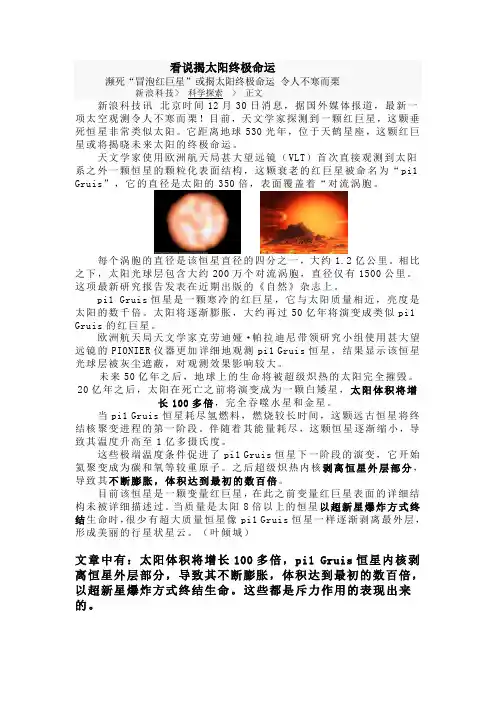
看说揭太阳终极命运濒死“冒泡红巨星”或揭太阳终极命运令人不寒而栗新浪科技> 科学探索> 正文新浪科技讯北京时间12月30日消息,据国外媒体报道,最新一项太空观测令人不寒而栗!目前,天文学家探测到一颗红巨星,这颗垂死恒星非常类似太阳。
它距离地球530光年,位于天鹤星座,这颗红巨星或将揭晓未来太阳的终极命运。
天文学家使用欧洲航天局甚大望远镜(VLT)首次直接观测到太阳系之外一颗恒星的颗粒化表面结构,这颗衰老的红巨星被命名为“pi1 Gruis”,它的直径是太阳的350倍,表面覆盖着“对流涡胞。
每个涡胞的直径是该恒星直径的四分之一,大约1.2亿公里。
相比之下,太阳光球层包含大约200万个对流涡胞,直径仅有1500公里。
这项最新研究报告发表在近期出版的《自然》杂志上。
pi1 Gruis恒星是一颗寒冷的红巨星,它与太阳质量相近,亮度是太阳的数千倍。
太阳将逐渐膨胀,大约再过50亿年将演变成类似pi1 Gruis的红巨星。
欧洲航天局天文学家克劳迪娅·帕拉迪尼带领研究小组使用甚大望远镜的PIONIER仪器更加详细地观测pi1 Gruis恒星,结果显示该恒星光球层被灰尘遮蔽,对观测效果影响较大。
未来50亿年之后,地球上的生命将被超级炽热的太阳完全摧毁。
20亿年之后,太阳在死亡之前将演变成为一颗白矮星,太阳体积将增长100多倍,完全吞噬水星和金星。
当pi1 Gruis恒星耗尽氢燃料,燃烧较长时间,这颗远古恒星将终结核聚变进程的第一阶段。
伴随着其能量耗尽,这颗恒星逐渐缩小,导致其温度升高至1亿多摄氏度。
这些极端温度条件促进了pi1 Gruis恒星下一阶段的演变,它开始氦聚变成为碳和氧等较重原子。
之后超级炽热内核剥离恒星外层部分,导致其不断膨胀,体积达到最初的数百倍。
目前该恒星是一颗变量红巨星,在此之前变量红巨星表面的详细结构未被详细描述过。
当质量是太阳8倍以上的恒星以超新星爆炸方式终结生命时,很少有超大质量恒星像pi1 Gruis恒星一样逐渐剥离最外层,形成美丽的行星状星云。
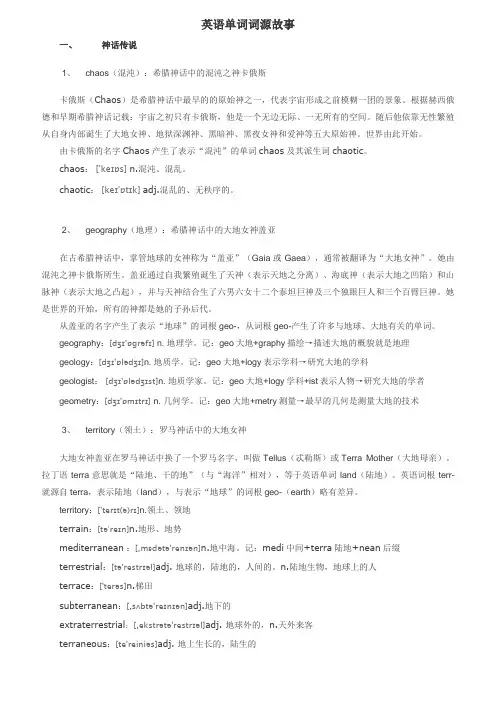
英语单词词源故事一、神话传说1、chaos(混沌):希腊神话中的混沌之神卡俄斯卡俄斯(Chaos)是希腊神话中最早的的原始神之一,代表宇宙形成之前模糊一团的景象。
根据赫西俄德和早期希腊神话记载:宇宙之初只有卡俄斯,他是一个无边无际、一无所有的空间。
随后他依靠无性繁殖从自身内部诞生了大地女神、地狱深渊神、黑暗神、黑夜女神和爱神等五大原始神。
世界由此开始。
由卡俄斯的名字Chaos产生了表示“混沌”的单词chaos及其派生词chaotic。
chaos:['keɪɒs]n.混沌、混乱。
chaotic:[keɪ'ɒtɪk]adj.混乱的、无秩序的。
2、geography(地理):希腊神话中的大地女神盖亚在古希腊神话中,掌管地球的女神称为“盖亚”(Gaia或Gaea),通常被翻译为“大地女神”。
她由混沌之神卡俄斯所生。
盖亚通过自我繁殖诞生了天神(表示天地之分离)、海底神(表示大地之凹陷)和山脉神(表示大地之凸起),并与天神结合生了六男六女十二个泰坦巨神及三个独眼巨人和三个百臂巨神。
她是世界的开始,所有的神都是她的子孙后代。
从盖亚的名字产生了表示“地球”的词根geo-,从词根geo-产生了许多与地球、大地有关的单词。
geography:[dʒɪ'ɒgrəfɪ]n. 地理学。
记:geo大地+graphy描绘→描述大地的概貌就是地理geology:[dʒɪ'ɒlədʒɪ]n. 地质学。
记:geo大地+logy表示学科→研究大地的学科geologist:[dʒɪ'ɒlədʒɪst]n. 地质学家。
记:geo大地+logy学科+ist表示人物→研究大地的学者geometry:[dʒɪ'ɒmɪtrɪ]n. 几何学。
记:geo大地+metry测量→最早的几何是测量大地的技术3、territory(领土):罗马神话中的大地女神大地女神盖亚在罗马神话中换了一个罗马名字,叫做Tellus(忒勒斯)或Terra Mother(大地母亲)。
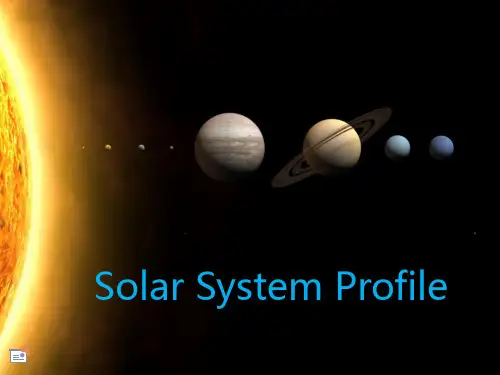
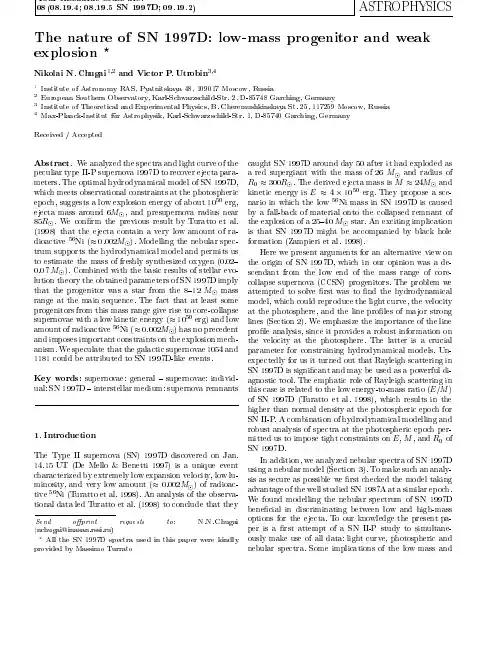
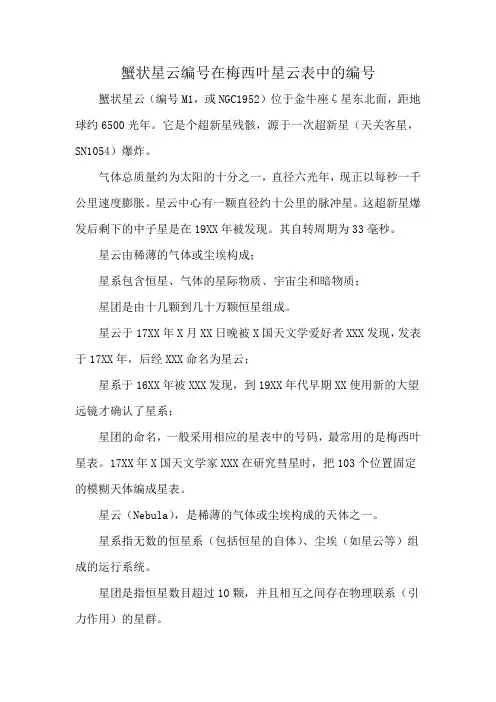
蟹状星云编号在梅西叶星云表中的编号蟹状星云(编号M1,或NGC1952)位于金牛座ζ星东北面,距地球约6500光年。
它是个超新星残骸,源于一次超新星(天关客星,SN1054)爆炸。
气体总质量约为太阳的十分之一,直径六光年,现正以每秒一千公里速度膨胀。
星云中心有一颗直径约十公里的脉冲星。
这超新星爆发后剩下的中子星是在19XX年被发现。
其自转周期为33毫秒。
星云由稀薄的气体或尘埃构成;
星系包含恒星、气体的星际物质、宇宙尘和暗物质;
星团是由十几颗到几十万颗恒星组成。
星云于17XX年X月XX日晚被X国天文学爱好者XXX发现,发表于17XX年,后经XXX命名为星云;
星系于16XX年被XXX发现,到19XX年代早期XX使用新的大望远镜才确认了星系;
星团的命名,一般采用相应的星表中的号码,最常用的是梅西叶星表。
17XX年X国天文学家XXX在研究彗星时,把103个位置固定的模糊天体编成星表。
星云(Nebula),是稀薄的气体或尘埃构成的天体之一。
星系指无数的恒星系(包括恒星的自体)、尘埃(如星云等)组成的运行系统。
星团是指恒星数目超过10颗,并且相互之间存在物理联系(引力作用)的星群。
没有星域这个概念。
红外云顶亮温在西北太平洋热带气旋强度预报中的应用Ξ陈佩燕1,2 端义宏1,2 余 晖1,2 胡春梅31中国气象局上海台风研究所,上海,2000302中国气象局台风预报技术重点开放实验室,上海,2000303重庆市气象台,重庆,401147摘 要 应用GMS25气象卫星红外云顶亮温(TBB)资料,分析西北太平洋的热带气旋(TC)TBB、TBB的对称和非对称分量与滞后0—48h TC强度的相关关系。
发现,TC眼墙附近东南侧的TBB、距TC中心半径0.8°—1.7°范围内TBB对称分量和1—10波振幅之和与0—48h的TC强度有很好的负相关关系,与滞后24h的TC强度相关极值分别达到-0.52,-0.59和-0.625。
考虑气候持续因子、天气因子及TBB因子,针对1996—2002年西北太平洋远海区域(0°—50°N,120°—155°E)热带风暴(TS)等级以上样本,建立12,24h和48h强度预报方程并进行独立样本检验。
结果表明,1.0°—1.5°环域平均的TBB对12h强度预报的方差贡献位居第4,TC东南侧TBB的平均值和1.1°—1.5°范围TBB极大与极小值之差对24h强度预报的方差贡献分列第3和第5位。
考虑TBB因子的回归方程对TS和强热带风暴(STS)的强度预报能力有较大提高,对12h内强度减弱15m/s以上TC的12h预报、强度稳定TC的24h预报和强度48h增强10m/s以上TC的48h预报均有所改善。
关键词:红外云顶亮温,非对称结构,热带气旋,强度预报。
1 引 言现阶段,对于热带气旋(TC)强度预报缺少有效的客观方法。
应用最早和最为广泛的是根据可见光和红外云图上TC云型和云系特征来估计及预报TC强度的Dvorak技术,在改进的客观Dvorak技术中[1],用TBB(T BB)资料确定TC中心的位置、眼和周边的温度,并估计TC参数指数。
高中英语科普阅读练习题50题含答案解析1. The sun is a star that provides the Earth with ____ energy.A. muchB. manyC. a fewD. a little答案解析:A。
本题考查形容词的用法。
energy是不可数名词,many和a few修饰可数名词,所以B和C选项排除。
a little表示少量的,much表示大量的,太阳提供给地球大量的能量,所以选A。
2. Which planet is known as the "Red Planet"?A. VenusB. MarsC. JupiterD. Saturn答案解析:B。
本题考查行星的常识。
Mars(火星)被称为“Red Planet”(红色星球),因为其表面富含氧化铁而呈现红色。
Venus(金星)、Jupiter( 木星)、Saturn( 土星)都不符合这一特征,所以答案是B。
3. Scientists believe that the universe is ____ expanding.A. constantlyB. occasionallyC. rarely答案解析:A。
本题考查副词的用法。
constantly表示不断地,科学家认为宇宙在不断地膨胀。
occasionally表示偶尔,rarely表示很少,never表示从不,都不符合宇宙膨胀这一科学认知,所以答案是A。
4. The moon orbits around ____.A. the sunB. the EarthC. MarsD. itself答案解析:B。
本题考查天文常识。
月亮是地球的卫星,它围绕地球运转。
所以答案是B。
5. Which of the following is the largest planet in our solar system?A. EarthB. NeptuneC. JupiterD. Uranus答案解析:C。
arXiv:astro-ph/0306376v1 18 Jun 2003CASSIOPEIAAANDITSCLUMPYPRESUPERNOVAWINDRogerA.ChevalierandJeffreyOishiDepartmentofAstronomy,UniversityofVirginia,P.O.Box3818,Charlottesville,VA22903;rac5x@virginia.edu,jo8c@virginia.edu
ABSTRACTTheobservedshockwavepositionsandexpansioninCasAcanbeinterpretedinamodelofsupernovainteractionwithafreelyexpandingstellarwindwithamasslossrateof∼3×10−5M⊙yr−1forawindvelocityof10kms−1.Thewindwasprobablystillbeinglostatthetimeofthesupernova,whichmayhavebeenofTypeIInorIIb.ThewindmayplayaroleintheformationofveryfastknotsobservedinCasA.Inthismodel,thequasi-stationaryflocculi(QSFs)representclumpsinthewind,withadensitycontrastofseveral103comparedtothesmoothwind.Theouter,unshockedclumpywindisphotoionizedbyradiationfromthesupernova,andisobservedasapatchyHIIregionaroundCasA.ThisgashasalowerdensitythantheQSFsandisheatedbynonradiativeshocksdrivenbytheblastwave.DenserclumpshaverecombinedandareobservedasHIcompactabsorptionfeaturestowardsCasA.
Subjectheadings:ISM:individual(CassiopeiaA)—supernovae—supernovaremnants
1.INTRODUCTIONThesupernovaremnantCasA(CassiopeiaA)givesusourbestviewoftheoutcomeoftheexplosionofamassivestar.SpectralimagingwithChandraatX-raywavelengths(Hughesetal.2000)andHSTatopticalwavelengths(Fesenetal.2001)hasshownthecomplexstructureoftheejectedheavyelements.TheChandraimagealsorevealedacentralcompactX-raysource(Tananbaum1999),probablyaneutronstar,andlinesoftheradioac-tiveisotope44Tihavebeendetected(Iyudinetal.1994).Despitethesemanydevelopments,theevolutionarystatusofCasAremainsuncertain.Themostcommonassumptionisthatthesupernovaisinteractingwithaconstantdensityinterstellarmedium(Gull1973b;Got-thelfetal.2001;DeLaney&Rudnick2003),orperhapswithamolecularcloud(Keohane,Rudnick,&Anderson1996).Interactionwithacircumstellarshellhasalsobeensuggested–2–(Chevalier&Liang1989;Borkowskietal.1996).Theimmediateenvironmentofamassivestarisexpectedtobestronglyinfluencedbymassloss,andthepervasive,high-velocity,heavyelementejectainCasAindicatethatthestarunderwentstrongmasslossbeforetheexplosion.
Here,weproposethatthesupernovaisinteractingwiththeslowwindfromthepro-genitorstar,withaρw∝r−2densityprofile.Theresultingmodelcanbecomparedtothewidthandexpansionoftheshockedregion(§2),givingconstraintsonthebasicparameters.Implicationsofthemodelforinhomogeneitiesinthethewind,forthesupernova,andforasurroundingHIIregionandHIknotsarediscussedin§3.
2.WINDINTERACTIONMODELThedistancetoCasAhasbeendeterminedfromthefastknotexpansiontobe3.4+0.3−0.1
kpc(Reedetal.1995).Ashworth(1980)claimedanobservationoftheCasAsupernovaby
Flamsteedin1680,butthatclaimhasbeencontroversial(Stephenson&Green2002).Onthebasisofveryfastknotsthatshowlittlesignofdeceleration,Thorstensenetal.(2001)determinedanexplosiondateof1671.3±0.9.Wetakeanexplosiondateof1675±5.TheoutershockfronthasbeenclearlyobservedinChandraimagestohavearadiusof153′′(Gotthelfetal.2001),or7.8×1018cmatadistanceof3.4kpc.Thepositionofthereverseshockfrontislessclear,butwasdeterminedbyGotthelfetal.(2001)fromtheinneredgetothebrightringofemissionatX-rayandradiowavelengths;theyfoundaratiooftheforwardshockradiustothatofthereverseshockofrf/rr=1.5withavariationof14%aroundtheremnant.
TheyouthofCasAhasenabledstudiesofitsexpansionfrompropermotionstudies.DeLaney&Rudnick(2003)haverecentlymeasuredtheexpansionoftheforwardshockinX-raysfromChandraobservationsover2000–2002andfoundittobeinthelargerange0.02−0.33%yr−1,withamedianof0.21%yr−1.Themediancorrespondstoanexpansionparametermf=dlnrf/dlntof0.68.ThebrightringofX-rayemissionhaspreviouslybeenfoundtobeexpandingat0.20±0.01%yr−1fromEinsteinandROSATobservationscovering1979–1996(Koraleskyetal.1998;Vinketal.1998),orm=0.62±0.03.Thebrightradioringisapproximatelyco-extensivewiththeX-rayone.Ag¨ueros&Green(1999)studiedtheminimainthevisibilityplaneat151MHzovertheperiod1984–1997todetermineatimescaleforthebulkringexpansionof460±30years,orm=0.69±0.05.WhilethisresultisconsistentwiththeX-rayexpansion,otherradiostudieshaveyieldedaslowerexpansion;Anderson&Rudnick(1995)findanexpansionageof750−1300years(m=0.33±0.11).DeLaney&Rudnick(2003)recentlyexaminedthemotionoftheradioringwithanemphasisonangle-